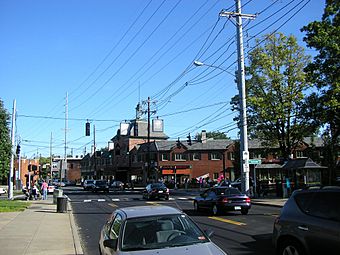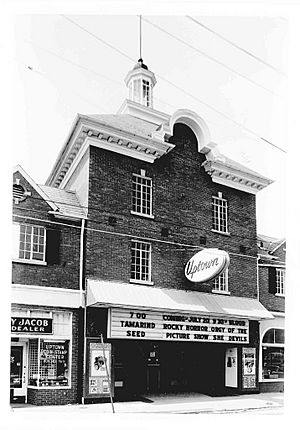Schuster Building facts for kids
Quick facts for kids |
|
|
Schuster Building
|
|

The Schuster Building in 2007
|
|
| Location | 1500 Bardstown Rd, Louisville, Kentucky |
|---|---|
| Built | 1927 |
| Architect | Nevin, Wischmeyer & Morgan |
| Architectural style | Colonial Revival |
| NRHP reference No. | 80001618 |
| Added to NRHP | October 18, 1980 |
The Schuster Building is a special building in Louisville, Kentucky. It is located where Bardstown Road and Eastern Parkway meet. This building is in an area called the Highlands.
In 1980, the Schuster Building was added to the National Register of Historic Places. This means it is an important historical place. It is a great example of a building style called Colonial Revival. This style was popular when the building was finished in 1927. It became even more famous after the restoration of Colonial Williamsburg.
Other buildings in Louisville also used the Colonial Revival style. For example, the University of Louisville Administration Building was built in 1929. Norton and Mullins halls at the Southern Baptist Theological Seminary were built in 1930.
Contents
History of the Schuster Building
The Schuster Building was designed by a company from Louisville called Nevin, Wischmeyer & Morgan. This company also designed the clubhouse for the Pendennis Club.
Building Design and Early Uses
The Schuster Building was built in 1927. It is about 35,000-square-foot (3,300 m2) in size. It was the biggest of several buildings built before World War II along Bardstown Road. This road was a busy shopping area in the Highlands. At that time, the Highlands was a wealthy area outside the city center.
When it first opened, the building had many uses. It had shops, offices for professionals, and apartments. It also had a large movie theater called the Uptown Theater. The Uptown Theater was about 14,000-square-foot (1,300 m2) and had 1,100 seats. It could show movies and host live shows. It even had a stage, an orchestra pit, and an organ.
Changes Over Time
The building stayed mostly the same until the 1980s. Shops changed, but the upper floors did not. The ground floor had only small changes. The Uptown Theater was a main part of the building. But fewer people came to watch movies over the years. By the 1980s, it was clear the theater would close. The Uptown Theater closed in 1989. It had been open longer than almost any other neighborhood theater in Louisville.
In the late 1980s and early 1990s, people living in the Highlands tried to save the Uptown Theater. They wanted to fix it up and open it again. They even thought about making it a film museum. But they could not raise the money needed for the project.
There were plans to tear down the theater to build a parking lot. But these plans stopped because the economy was slow. While the building was waiting, people suggested other uses for it. Some ideas were a public library, a dance hall, or a new movie theater with eight screens. Neighbors were worried about the building's future. In 1992, it was listed as one of the 10 "most-endangered" buildings in Louisville.
The idea for a new movie theater got a lot of support. But many neighbors did not like it. They worried about safety, traffic, and parking. So, the developers decided not to build the cinema. In 1996, a new multi-screen cinema opened nearby. It was called Baxter Avenue Theatres.
In 1994, the Uptown Theater was torn down. This made a large space behind the building for a parking lot. The property became busy again when a restaurant and other businesses moved in. The apartments on the second and third floors were changed into office spaces.
Even though the Uptown Theater is gone, the outside of the building still looks much the same. The old lobby of the theater is now the dining room of a Qdoba restaurant. You can still see the old ticket window as part of the storefront.
How the Building Influenced the Area
The Schuster Building is a landmark in its area. It has influenced other buildings nearby. For example, a Valvoline shop across the street used bricks that matched the Schuster Building. A large building on the opposite corner, called Highland Station, was designed to look like the Schuster Building. It has shops close to the sidewalk and outdoor dining.


